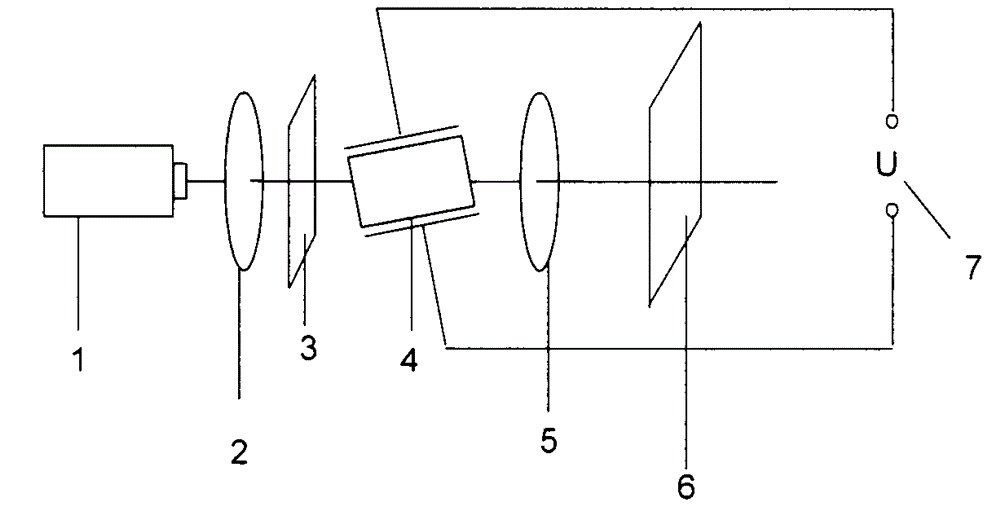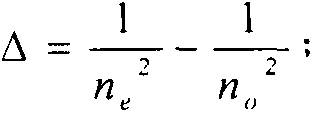Electro-optical crystal electro-optical factor measure method and device
A technology of electro-optic crystals and electro-optic coefficients, applied in the direction of measuring devices, measuring electricity, measuring electrical variables, etc., can solve the problems of large measurement errors, complicated adjustments, and difficulty in accurately determining the position of extreme values, and achieve the image of the measurement process, the instrument The effect of simple equipment and easy adjustment
- Summary
- Abstract
- Description
- Claims
- Application Information
AI Technical Summary
Problems solved by technology
Method used
Image
Examples
Embodiment 1
[0027] 1. Theoretical analysis: The electro-optic crystal to be tested is a lithium niobate crystal with a size of X×Y×Z=9mm×9mm×18.5mm (X, Y, Z represent crystallographic directions, the same below), doped with 6.5mol% magnesium , by the electro-optic coefficient γ to be measured 22 Determine the direction of the applied voltage as the x-axis direction of the crystal. According to the electro-optic effect and the theory of the refractive index ellipsoid, it can be obtained that the inductive main axes x', y' are rotated 45° relative to the original axes x, y, and z' is the same as the z-axis.
[0028] In the case of applying DC voltage, at any angle (θ, φ) (θ is the angle between the laser propagation direction and the z' axis, φ is the angle between the projection of the laser propagation direction on the x'oy' plane and the x' axis ) The phase difference due to birefringence when the incident laser passes through the crystal is:
[0029] δ ...
Embodiment 2
[0046] 1. Theoretical analysis: The electro-optic crystal to be tested is a nominally pure lithium niobate crystal with a size of X×Y×Z=9mm×9mm×18.8mm. The electro-optic coefficient γ to be measured is 22 Determine the direction of the applied voltage as the x-axis direction of the crystal. According to the electro-optic effect and the theory of the refractive index ellipsoid, it can be obtained that the inductive main axes x', y' are rotated 45° relative to the original axes x, y, and z' is the same as the z-axis.
[0047] In the case of applying DC voltage, at any angle (θ, φ) (θ is the angle between the laser propagation direction and the z' axis, φ is the angle between the projection of the laser propagation direction on the x'oy' plane and the x' axis ) The phase difference due to birefringence when the incident laser passes through the crystal is:
[0048] δ 1 = π n ...
Embodiment 3
[0065] 1. Theoretical analysis: The electro-optic crystal to be tested is a nominally pure lithium niobate crystal with a size of X×Y×Z=9mm×9mm×9.8mm. The electro-optic coefficient γ 22 Determine the direction of the applied voltage as the x-axis direction of the crystal. According to the electro-optic effect and the theory of the refractive index ellipsoid, it can be obtained that the inductive main axes x', y' are rotated by 45 relative to the original axes x, y, and z' is the same as the z-axis.
[0066] In the case of applying DC voltage, at any angle (θ, φ) (θ is the angle between the laser propagation direction and the z' axis, φ is the angle between the projection of the laser propagation direction on the x'oy' plane and the x' axis ) The phase difference due to birefringence when the incident laser passes through the crystal is:
[0067] δ 1 = π n ...
PUM
| Property | Measurement | Unit |
|---|---|---|
| Electro-optic coefficient | aaaaa | aaaaa |
| Electro-optic coefficient | aaaaa | aaaaa |
| Electro-optic coefficient | aaaaa | aaaaa |
Abstract
Description
Claims
Application Information
 Login to View More
Login to View More - R&D
- Intellectual Property
- Life Sciences
- Materials
- Tech Scout
- Unparalleled Data Quality
- Higher Quality Content
- 60% Fewer Hallucinations
Browse by: Latest US Patents, China's latest patents, Technical Efficacy Thesaurus, Application Domain, Technology Topic, Popular Technical Reports.
© 2025 PatSnap. All rights reserved.Legal|Privacy policy|Modern Slavery Act Transparency Statement|Sitemap|About US| Contact US: help@patsnap.com



